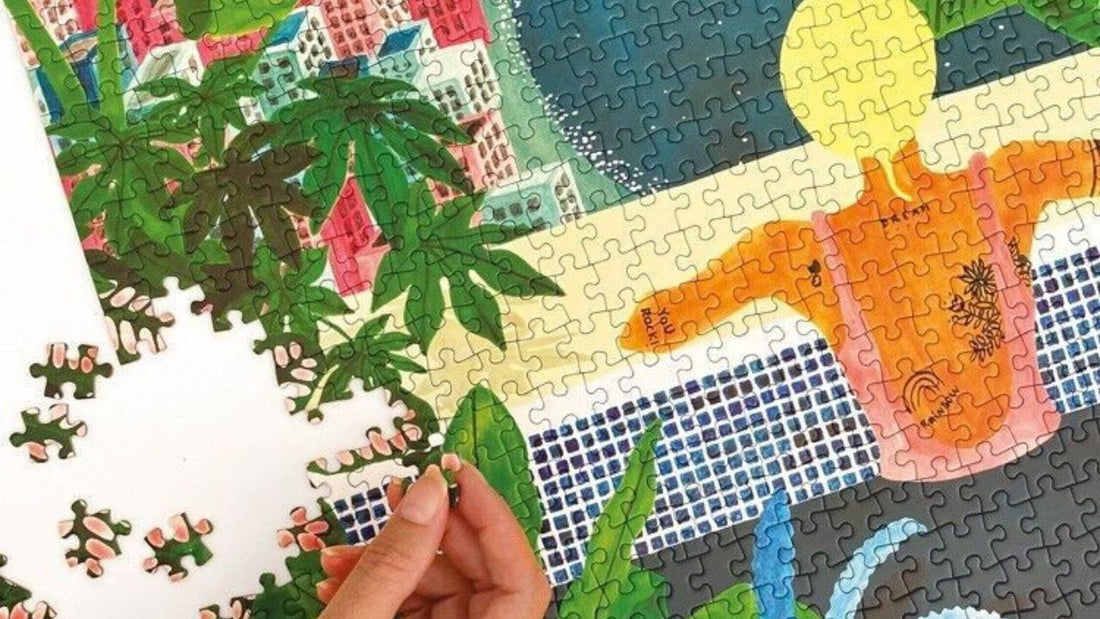Far from being a simple game for children, the puzzle is a real source of relaxation, concentration and cognitive stimulation.
Whether you're a novice or a seasoned puzzler, there are plenty of puzzles to suit all tastes and levels. You will inevitably find the puzzle that will thrill you.
In this article, we will reveal all our secrets to putting together your puzzles brilliantly and guide you through the techniques of the pros.
Keep reading to discover the secrets of a successful puzzle!
1) Set the stage for a successful puzzle
Choosing the Perfect Puzzle
1. Find the right level of difficulty:
Whether you are a novice or an experienced puzzler, you need to choose a puzzle suited to your experience level.
For beginners, opt for a puzzle with a reduced number of pieces (50 to 200 pieces) and simple patterns.
More experienced puzzlers may gravitate towards more complex puzzles (1000 to 5000 pieces) or more demanding themes, such as detailed landscapes or abstract works of art.
Click here to discover our puzzles for adults !
2. Take inspiration from your personal tastes:
The choice of theme is essential to arouse your interest and motivation throughout the assembly.
Choose images that attract you, whether they are picturesque landscapes, fascinating animals, scenes from cult films or decorative and design puzzles ... there is something for everyone!
3. Consider the size and available space:
Before you start, make sure you have enough space to accommodate your puzzle.
If you are limited on space, opt for a modestly sized puzzle. For larger puzzles, consider clearing a sufficiently spacious table or flat surface.

Find a suitable place
1. Favor a calm and bright environment:
Good lighting will help you distinguish the details of rooms and avoid eye fatigue.
Sit in a bright room, ideally near a window.
If natural light is insufficient, do not hesitate to use a desk lamp or additional lighting.
2. Choose a flat and stable surface:
The surface on which you assemble your puzzle must be flat and stable to prevent the pieces from scattering or sliding.
A dining table, a desk or a rigid tray will do the job perfectly.
If you use a puzzle mat, make sure it adheres well to the surface and is large enough to accommodate all of the pieces.
3. Organize rooms for efficiency:
To save time and increase efficiency, take the time to sort the pieces of your puzzle before starting.
You can organize them by color, shape, borders, or any method that suits you.
Gather the necessary accessories
1. Protect your creation with a puzzle mat:
A felt or foam puzzle mat is a valuable accessory to protect your puzzle in progress.
It helps hold the pieces in place, prevents scratches and makes it easier to move the puzzle from one place to another.
2. Sort and organize with boxes or trays:
Shallow boxes or trays will be useful for sorting and organizing your puzzle pieces.
You can use them to separate pieces by color, shape, or a method of your choice.
This will save you time and keep your workspace clean.

2) The techniques of puzzle professionals
A. Start with the borders
The borders are the skeleton of the puzzle and provide a solid foundation for assembling the remaining pieces. Here are some tips for assembling borders effectively:
B. Pay attention to visual cues
The puzzles are full of visual clues that can guide you through assembly. Train your eye to spot these clues to progress faster:
C. Implement an assembly strategy
Approaching a puzzle with a well-defined assembly strategy will allow you to progress in an organized and efficient manner. Here are a few tips :
3) Cultivate patience and perseverance for a successful puzzle
A. Managing frustration with stubborn parts
Even the most experienced puzzlers sometimes run into stubborn pieces. Faced with these obstacles, here are some tips for managing frustration and overcoming these difficulties:
- If a piece doesn't seem to fit, don't be discouraged. Take the time to examine it carefully and compare it to neighboring rooms.
- If a piece continues to resist you, leave it aside temporarily. Move on to another section of the puzzle and come back to that piece later with fresh eyes.
- Try changing your viewing angle by looking at the puzzle from another angle or turning it over.
B. Knowing how to adapt and change approach
Faced with the challenges presented by a puzzle, you must know how to adapt and change your approach if necessary.
If one joining technique doesn't work for a particular section, don't hesitate to try another. You could, for example, move from a color strategy to a shape or pattern approach.
If you find yourself stuck in a section and feel like you're treading water, don't hesitate to take the pieces apart and start again.
Remember that the main purpose of a puzzle is to have fun and relax. Don't put pressure on yourself to finish quickly and take the time to enjoy the assembly process. Each piece placed is a victory in itself!
Far from being simple entertainment, the puzzle is an activity with multiple benefits for logical thinking and creativity. It also allows you to relax, disconnect from everyday life and reduce stress.
So, don't hesitate to embark on the fascinating world of puzzles!
